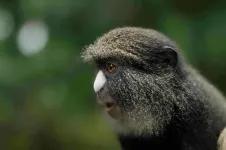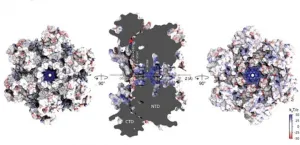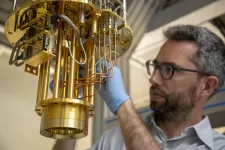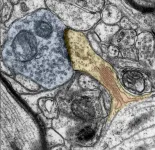First images of freshwater plumes at sea
Surface-towed marine controlled-source electromagnetic (CSEM) imaging can be used to map oceanic freshwater plumes in high-resolution
2021-03-31
(Press-News.org) The first imaging of substantial freshwater plumes west of Hawai'i Island may help water planners to optimize sustainable yields and aquifer storage calculations. University of Hawai'i at Mānoa researchers demonstrated a new method to detect freshwater plumes between the seafloor and ocean surface in a study recently published in Geophysical Research Letters.
The research, supported by the Hawai'i EPSCoR 'Ike Wai project, is the first to demonstrate that surface-towed marine controlled-source electromagnetic (CSEM) imaging can be used to map oceanic freshwater plumes in high-resolution. It is an extension of the groundbreaking discovery of freshwater beneath the seafloor in 2020. Both are important findings in a world facing climate change, where freshwater is vital for preserving public health, agricultural yields, economic strategies, and ecosystem functions.
Profound implications
While the CSEM method has been used to detect the presence of resistive targets such as oil, gas and freshwater beneath the seafloor, this study is the first time CSEM was applied to image freshwater in the ocean water column, according to 'Ike Wai research affiliate faculty Eric Attias, who led the study.
"This study has profound implications for oceanography, hydrogeology and ocean processes that affect biogeochemical cycles in coastal waters worldwide," said Attias. "Using CSEM, we now can estimate the volumes of freshwater emanating to the water column. This is indicative of the renewability of Hawai'i's submarine freshwater system."
Submarine groundwater discharge (SGD), the leaking of groundwater from a coastal aquifer into the ocean, is a key process, providing a water source for people, and supporting sea life such as fish and algae. According to UH Mānoa Department of Earth Sciences Associate Professor and study co-author Henrietta Dulai, the location of offshore springs is extremely hard to predict because of the unknown underlying geology and groundwater conduits.
"The flux of such high volumes of nutrient-rich, low salinity groundwater to the ocean has great significance for chemical budgets and providing nutrients for offshore food webs," said Dulai. "It is great to have a method that can pinpoint discharge locations and plumes as it opens up new opportunities to sample and identify the age of the water, its origin, chemical composition, and its significance for marine ecosystems in this otherwise oligotrophic (relatively low in plant nutrients and containing abundant oxygen in the deeper parts) ocean."
Four Olympic swimming pools
This study included electromagnetic data driven 2D CSEM inversion, resistivity-to-salinity calculation, and freshwater plume volumetric estimation. Through the use of CSEM, the research team was able to image surface freshwater bodies and multiple large-scale freshwater plumes that contained up to 87% freshwater offshore Hawai'i Island. The results imply that at the study site substantial volumes of freshwater are present in the area between the seafloor and the ocean's surface. A conservative estimate for one of the plumes suggests 10,720 cubic meters or approximately the volume of four Olympic-sized swimming pools.
The methodology used in this study can be applied to coastal areas worldwide, thus improving future hydrogeological models by incorporating offshore SGD and optimizing sustainable yields and storage calculations. Attias plans to extend the novel use of CSEM to further prove its application in imaging freshwater at other volcanic islands around the globe.
Attias will present his work at the International Tropical Island Water Conference taking place April 12-15, 2021. Hosted by the UH Water Resources Research Center and Hawai'i EPSCoR, this conference brings together water scientists, water managers and community members from around the world to share cutting-edge research and learn from each other's experiences managing and understanding water resources across a broad range of tropical island settings.
INFORMATION:
Link to video and sound (details below): https://bit.ly/3coZZSw
This project is supported by the National Science Foundation EPSCoR Program Award
Video: (TRT 1:40)
Broll:
:00-:03 Video of deployment of the CSEM system offshore Hawai'i Island
:04-:07 Animation of Earth zoom into Hawai'i Island
:08-:12 Map of CSEM offshore Hawai'i Island
:13-:21 2 shots video of deployment of the CSEM system offshore Hawai'i Island
:22-:24 Illustration of the surface-towed marine controlled-source electromagnetic (CSEM) system.
:25-:30 Map of survey area
:31-:41 2-dimensional model derived from CSEM data and illustration showing salinity distribution along the freshwater plume
:42-:59 Conceptual model of hydrologic system offshore Hawai'i
1:00-1:06 Eric Attias, University of Hawai'i research affiliate faculty, walking
1:06-1:11 freshwater bubbling up at the shoreline
Sound:
Eric Attias, University of Hawai'i affiliate researcher (:14)
"Ok, we kind of have now a proof of concept that is paradigm shift from all the studies that have been done in the last 50 years of what happened to the groundwater system in volcanic islands."
Attias (:10)
"We're hoping to conduct similar studies to prove that what we see in Hawai'i is the governing mechanism of volcanic islands."
YouTube video:
https://youtu.be/D0rqJXhgWas
[Attachments] See images for this press release:

ELSE PRESS RELEASES FROM THIS DATE:
2021-03-31
LOWELL, Mass. - Researchers studying mercury gas in the atmosphere with the aim of reducing the pollutant worldwide have determined a vast amount of the toxic element is absorbed by plants, leading it to deposit into soils.
Hundreds of tons of mercury each year are emitted into the atmosphere as a gas by burning coal, mining and other industrial and natural processes. These emissions are absorbed by plants in a process similar to how they take up carbon dioxide. When the plants shed leaves or die, the mercury is transferred to soils where large amounts also make their way into watersheds, threatening wildlife and people who eat contaminated fish.
Exposure to high levels of mercury over long ...
2021-03-31
BRAZZAVILLE, Republic of Congo (March 31, 2021) - Researchers with the Wildlife Conservation Society's (WCS) Congo Program and the Nouabalé-Ndoki Foundation found that female putty-nosed monkeys (Cercopithecus nictitans) use males as "hired guns" to defend from predators such as leopards.
Publishing their results in the journal Royal Society Open Science, the team discovered that female monkeys use alarm calls to recruit males to defend them from predators. The researchers conducted the study among 19 different groups of wild putty-nosed monkeys, a type of forest guenon, in Mbeli Bai, a study area within the forests in Nouabalé-Ndoki National Park, Northern Republic of Congo.
The results promote the idea that females' general alarm requires males to assess the nature ...
2021-03-31
(Denver, Colo., -- March 31, 2021)- A new Molecular Database Project initiated by the International Association for the Study of Lung (IASLC) will accelerate the understanding of lung cancer biology, clinical care and care delivery on a global scale and will improve the prognosis and optimal treatment of lung cancer across time and space, according to an editorial in the Journal of Thoracic Oncology, an official journal of the IASLC. The editorial can be viewed here: https://www.jto.org/article/S1556-0864(21)01781-0/fulltext.
In the editorial, the IASLC Staging and Prognostic Factors Committee's Molecular Sub-Committee, and committee members, emphasized that there is great opportunity, with the emergence of molecular biomarkers of disease behavior, to improve ...
2021-03-31
Viruses lurk in the grey area between the living and the nonliving, according to scientists. Like living things, they replicate but they don't do it on their own. The HIV-1 virus, like all viruses, needs to hijack a host cell through infection in order to make copies of itself.
Supercomputer simulations supported by the National Science Foundation-funded Extreme Science and Engineering Discovery Environment (XSEDE) have helped uncover the mechanism for how the HIV-1 virus imports into its core the nucleotides it needs to fuel DNA synthesis, a key step in its replication. It's the first example ...
2021-03-31
The qubit is the building block of quantum computing, analogous to the bit in classical computers. To perform error-free calculations, quantum computers of the future are likely to need at least millions of qubits. The latest study, published in the journal PRX Quantum, suggests that these computers could be made with industrial-grade silicon chips using existing manufacturing processes, instead of adopting new manufacturing processes or even newly discovered particles.
For the study, researchers were able to isolate and measure the quantum state of a single electron (the qubit) in a silicon transistor manufactured using a 'CMOS' technology similar to that used to make chips in computer processors.
Furthermore, the spin of the electron was found to remain stable for a period of up ...
2021-03-31
Neuroscientists agree that a person's brain is constantly changing, rewiring itself and adapting to environmental stimuli. This is how humans learn new things and create memories. This adaptability and malleability is called plasticity. "Physicians have long suspected that remodeling processes also take place in humans at the contact points between nerve cells, i.e. directly at the synapses. Until now, however, such a coordinated adaptation of structure and function could only be demonstrated in animal experiments," says Prof. Dr. Andreas Vlachos from the Institute of Anatomy and Cell Biology at the University of Freiburg. But now Vlachos, together with Prof. Dr. Jürgen Beck, head of the Department of Neurosurgery at the University Medical Center Freiburg, has provided experimental evidence ...
2021-03-31
Astronomers have detected X-rays from Uranus for the first time, using NASA's Chandra X-ray Observatory. This result may help scientists learn more about this enigmatic ice giant planet in our solar system.
Uranus is the seventh planet from the Sun and has two sets of rings around its equator. The planet, which has four times the diameter of Earth, rotates on its side, making it different from all other planets in the solar system. Since Voyager 2 was the only spacecraft to ever fly by Uranus, astronomers currently rely on telescopes much closer to Earth, like Chandra and the Hubble Space Telescope, to learn about this distant and cold planet that is made up almost entirely of hydrogen and helium.
In the new study, researchers used Chandra observations ...
2021-03-31
In 1890, psychologist William James described attention as the spotlight we shine not only on the world around us, but also on the contents of our minds. Most cognitive scientists since then have drawn a sharp distinction between what James termed "sensorial attention" and "intellectual attention," now usually called "attention" and "working memory," but James saw them as two varieties of the same mental process.
New research by Princeton neuroscientists suggests that James was on to something, finding that attention to the outside world and attention to our own thoughts are actually two sides of the same neural coin. What's more, they have observed the coin as it flips inside the brain.
A paper published in Nature on March 31 by END ...
2021-03-31
Using complementary computing calculations and neutron scattering techniques, researchers from the Department of Energy's Oak Ridge and Lawrence Berkeley national laboratories and the University of California, Berkeley, discovered the existence of an elusive type of spin dynamics in a quantum mechanical system.
The team successfully simulated and measured how magnetic particles called spins can exhibit a type of motion known as Kardar-Parisi-Zhang, or KPZ, in solid materials at various temperatures. Until now, scientists had not found evidence of this particular phenomenon outside of soft matter ...
2021-03-31
WASHINGTON (March 31, 2021) -- In 2019, Blacks, Latinos and Native Americans were severely underrepresented in the health care workforce, a trend that shows limited signs of improvement, according to a study published today by George Washington University researchers.
"Our findings suggest that Blacks, Latinos and other people of color have been left behind when it comes to the health professions," Edward Salsberg, senior research scientist and co-director of the Health Workforce Diversity Tracker project at the GW Fitzhugh Mullan Institute for Health Workforce Equity, said. The Fitzhugh Mullan Institute ...
LAST 30 PRESS RELEASES:
[Press-News.org] First images of freshwater plumes at sea
Surface-towed marine controlled-source electromagnetic (CSEM) imaging can be used to map oceanic freshwater plumes in high-resolution







